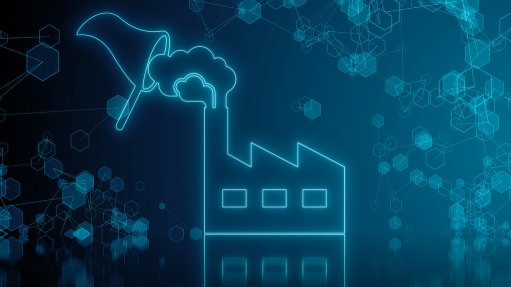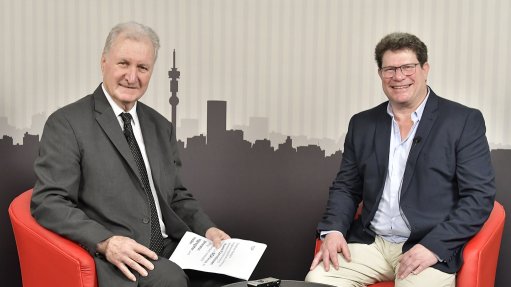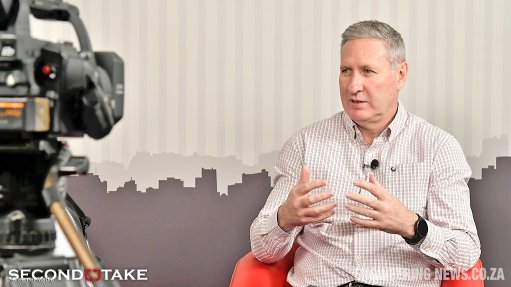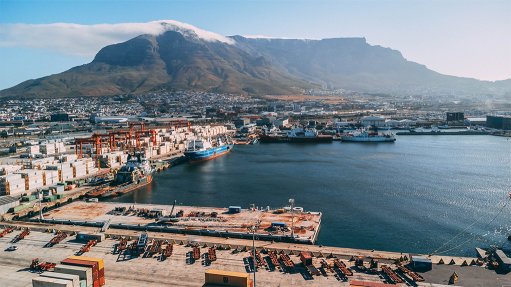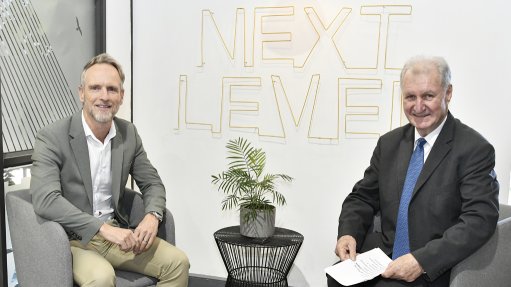Platinum-based PEM technology at heart of everything we do, says Plug Power of US

Plug Power's Andy Marsh interviewed by Mining Weekly's Martin Creamer. Video: Martin Creamer.
JOHANNESBURG (miningweeky.com) – In a Zoom video interview with Creamer Media’s Engineering News & Mining Weekly, Plug Power president and CEO Andy Marsh on Wednesday pointed out that platinum-based proton exchange membrane (PEM) technology is at the heart of everything that this Nasdaq-listed company does.
Plug is a prime mover in the US’s platinum-catalysed green hydrogen and fuel cell economy and the adoption by US business of this planet-friendly way of doing things is because it pays them to do so.
The company built and operates the US’s largest liquid green hydrogen plant, a 15 t a day liquid hydrogen plant that uses 40 MW of Plug’s platinum- and iridium-catalysed electrolysers.
More than 80 000 forklift trucks are powered by the 250 hydrogen fuelling stations it has built.
Between Walmart and Amazon, there are about 150 sites that use Plug’s PEM technology to operate around the clock.
With the help of Plug’s technology, these companies talk about moving 8% to 10% more pallets an hour, while also being users of clean energy.
“Where you need fast start-up, where you need to be able to work in cold environments, where you can really change the power level instantaneously, PEM is the answer,” Marsh highlighted.
Plug has a $1.66-billion loan contract with the US Department of Energy (DoE) to build a huge hydrogen plant in Texas. The DoE has been actively involved in research and development of green hydrogen and fuel cell technologies, recognising their potential to decarbonise various sectors and contribute to a cleaner energy future.
The DoE’s hydrogen and fuel cell technologies office has been focused on developing technologies that can produce hydrogen at $2/kg by 2026 and $1/kg by 2031 via net-zero-carbon pathways, in support of the Hydrogen Energy Earthshot goal of reducing the cost of hydrogen by 80% to $1/kg in one decade.
This has been under way against the backdrop of the Inflation Reduction Act (IRA), which was introduced to save the universe from the potentially catastrophic consequences of climate change.
Stimulated has been heavy investment in clean energy, climate action, and environmental justice, with the aim of reducing greenhouse-gas emissions and transitioning to an environmentally protective economy.
The IRA legislation that former President Joe Biden signed into law in August 2022 has the capacity to enable $3-trillion in climate investments in the 2022–2032 period and $11-trillion in overall infrastructure investments by 2050.
Key ingredients to the success of all this are platinum group metals, which South Africa hosts in greatest abundance.
Although platinum group metals are not subject to the latest US tariff impositions, reverberations of Wednesday's US April 2 'Liberation Day' announcement are being felt, given the 30% tariff regime imposed on South Africa, amid the 10% base tariff, as well as alongside higher individual tariffs for specific countries, including 20% for the EU, 24% for Japan, 26% for India, and 34% for China.
“I’ve spent some time with the DoE. I've spent some time with many Republican Congress folks. Now, there's certainly no guarantee that many of the incentives that were put in place to grow the green hydrogen industry will continue, but I think it's likely they will.
“There's over 20 members of the House who are Republicans who asked the President and asked the Speaker not to change the provisions of the IRA when it comes to hydrogen.
“It's an industry that's strongly supported by the oil and gas industry. There are some big projects, especially in places like Texas, including our own 45 ton liquid plant, that are still on the drawing board.
“There will be hydrogen hubs in the United States. It probably isn't happening as fast as people hoped three or four years ago, but we really do believe it's going to continue,” said Marsh.
Augmenting its US growth is the outstanding green hydrogen and fuel cell acclaim that this early-moving green company has generated since being established in 1997.
Plug has won considerable recognition in Europe and Australia, and is encouraging Africa to build out its energy grid network using lower-cost solar and wind and including green hydrogen and fuel cells development. In this way, a percentage of minerals that Africa hosts in such abundance can be used by Africa and in Africa through the development of industries that create sustainable employment in the new planet-friendly electrification world for the people of Africa.
Interestingly, there are times in the day when the renewable energy comes free of charge and can, during those low-use periods, be used to generate green hydrogen for use during periods of peak electricity demand. (Also watch attached Creamer Media video.)
Engineering News & Mining Weekly: As South Africans, we love PEM, because it signals that there's been use of platinum group metals, which we host in great abundance. Give us more insight into Plug's use of PEM.
PEM is the heart of what we do for both fuel cells and electrolysers. We move about 35% of the retail food in the United States, and we use exclusively PEM technology, and platinum’s a big part of my life. I think we’ve also done more deployments of PEM electrolysers in the Western world than anyone else, and they use platinum as well as iridium. We are a pure PEM house, and when you think about applications where you need fast start-up, where you need to be able to work in cold environments, where you can really change the power level instantaneously, PEM is really the answer. There's always a lot of debate about how much platinum, how much Iridium, we're going to use. Believe it or not, there’ll come a day where it won't be fossil fuels anymore, and the world will be using iridium and platinum in fuel cells and electrolysers.
Well, there's great alignment between us, then?
Yes, there is, we need your metals.
How many functioning operations has Plug Power enabled – and how many projects does it have on the go in the US?
There are about 250 hydrogen fuelling stations in the US that were built by Plug that power over 80 000 forklift trucks. Between Walmart and Amazon, there are probably 150 sites that use Plug’s PEM technology to operate 24/7. And why do they do it? They like being sustainable, but what they're really doing it for is that they can move goods faster. With Plug’s technology, these companies talk about moving 8% to 10% more pallets per hour, which really makes their operation more efficient. We also take power off the grid and that's important today, because big sellers are things like refrigerated foods, and that power can help them expand refrigerant capacity. So, there is a true value proposition, which is what we really need in this industry to make a difference, and it goes beyond sustainability. It goes to the heart. We help you save money, and that's what we offer at Plug, and that's why our customers are using our products. We also have lots of PEM electrolysers out there, and I’m sure we’ll touch on it during our discussion.
What contribution is Plug Power making to the growth of the green hydrogen and fuel cell economy in Europe?
We have some big deployments, especially in our electrolyser business, in Europe. For example, we're doing 100 MW electrolyser site with Galp, which is the largest refiner in Portugal. We're doing a big deal in Spain with Iberdrola. We probably have deployed more PEM electrolysers than anyone else in Europe, and it's a real interesting market. If you take a step back, some of these markets for fuel cells and hydrogen have been really difficult. But when you start thinking about where people are moving to green hydrogen, they're actually moving to applications in which they can substitute. Galp uses a lot of grey hydrogen in refining. Now they're going to be mixing in green hydrogen, and that really helps them reduce their taxes, because of the tax on carbon in Europe, so there's a real market and opportunity to help these companies in the oil and gas industry to save a lot of money, and all they really have to do is replace natural gas reformers with electrolysers. It's a pretty simple value proposition when you compare it to if you're doing on-road trucking, where you have to change the supply chain for trucking. You have to think about service. You have to think about financing. You have to think about where fuelling stations are. That's where the market is today is substitution for ammonia, and I think everybody in the world has figured out that green ammonia is really important in the fertilising industry. Also, in places like Australia, where they're looking to ship green ammonia into Japan and South Korea to burn that ammonia to help them meet their carbon footprint. I really like these activities that we have going on the electrolyser business. We're actually working on eight gigawatts (8 GW) worth today. That's a lot of ammonia, a lot of methanol, but these opportunities are not something that's futuristic. These opportunities are going to be happening. Deals are being cut now, projects are being deployed. It's real today, and that's really what Plug is involved in.
What contribution is Plug Power making to the growth of the green hydrogen and fuel cell economy in Australia?
Australia makes its living shipping minerals from Australia into the rest of Asia, into the world, and Australians are trying to figure out how they can ship the sun and wind to the rest of the world, and the best way for them to ship the sun and wind is to make hydrogen or to make green ammonia and green methanol. We have some really exciting projects going on. One is a project that's looking to do over two gigawatts (2 GW) of electrolysers to produce green ammonia, to put it really into the value chain for ammonia today. The government wants to continue to be an exporter and the best thing they got to export is the sun, and the best way to export the sun to Korea and Japan is to make green ammonia or green methanol or green hydrogen, and Plug’s right in the middle of all that.
How are you viewing the African market? You haven’t really participated in the African market to any great extent, or have you?
We have, a little, and I think it’s a great opportunity, especially where you are in South Africa. We actually built a big fuelling station in South Africa for Anglo American at one time as they looked at deploying fuel cells into the mining industry. The key issue with Africa is to understand how these projects can be financed. We probably have two or three projects going on in Africa, but one of the key elements is the willingness of financiers to back these projects, and, especially when it comes to electrolyser business, we really follow those projects. But governments can help, too. It's a real interesting industry, and a place like South Africa really should think about it. One of the things we're most proud of is that we have probably 1 500 blue collar workers of Plug Power who are getting on-hands experience with new technologies, working on fuel cells and electrolysers, adding to their capabilities list. I would love to find a way to do more deals in Africa. I hope that the governments are supportive of that activity and take an entrepreneurial attitude. I know that in many places in Africa, you need help from governments around the world, but I think it’s a great way to grow Africa. I come from the telecom industry. When I was a young kid, I worked for Bell Laboratories and I was fortunate enough to work in the wireless market, from an early age, back in the early 80s, when people really didn't know what wireless was. But countries in Africa, and countries like India and China, never built out a landline. They jumped to the latest and greatest technology. I would suggest that Africa, when they look to building out their energy grid, bypass the old fossil fuel industry and move into solar, wind and hydrogen and fuel cells, and that's really how I would hope the continent evolves, and hope that would provide great opportunities for companies like Plug.
South Africa had the European Commission President Ursula von der Leyen here, and she said to us, you've got superior sun, you've got prime wind, you’ve got 91% of the platinum group metals. You’ve got experience in electrolysers. You've done fuel cell insights. Now you can get going because we are wanting green hydrogen. She also put forward a stimulus package worth something like € 4.4-billion, so I hope something comes out of that as well.
I think Ursula said it much more elegantly than I did, that there are lots of opportunities for everyone in the southern hemisphere. South America is in a very similar position. There's so much opportunity to be able to leverage clean, natural resources as well as minerals, to really boost the economy. You want to make sure you're also creating good jobs that expand beyond the extraction industry, that build industries around electrolysers, build industries around fuel cells, build industries in the electrification world. Not only do you want to be a net exporter of minerals, you want to really be involved in the technologies that you're using to power the energy future.
What is your global vision for the deployment of green hydrogen and fuel cells across the universe?
I’m an optimist, and I believe we never do things easy in the world, and changing the energy system in the world from a fossil fuel base to a clean fuel based world is really challenging. But I want to think about Germany for a second, because I think it's probably a model for where I would like to see the world go and really the world where hydrogen will go. But you know, in Germany, in May of last year, 11% of the time the cost of electricity was negative. When you have all these renewables on the grid, there's an opportune time that one could be creating green hydrogen, and electrolysers essentially become part of the grid, and the global grid when it becomes 30% to 40% renewable is going to have peaks and valleys. During the peaks, you've got to be able to provide electricity beyond what the renewables are providing, but fuel cells and stored hydrogen can provide that extra boost during those portions, when electrical demands are greatest at six o'clock at night. That's really the world that I see. It's a world where wind and solar is everywhere, where stationary fuel cells are replacing natural gas generators, and it’s a clean world, and it's a place where companies like Plug, but also the many other companies that are developing and designing electrolysers, are part of the network, and the cost of creating the fuel is less than natural gas. At that point, the game's over, and it is a point that will happen because the fuel source, at many times, is going to be free, and it becomes, what's the cost of electricity, what's the cost of the equipment and electrolysers and construction. Companies like Plug have seen that every time we double the number of units in the field, our costs will go down by 25%. Just as it's now lower cost to do solar plants than coal plants, we're going to reach the point when it's going to be lower cost to do electrolyser fuel cell-based plants than to do natural gas generators. At that point, game's over, and it's really a function of how renewable the grids will become. We're really looking forward to a planet that uses more nuclear power, too, and again, electrolysers are a great thing to be sitting there during the night generating hydrogen, and, during the day, fuel cells using that hydrogen can support the peak loads for nuclear power plants. That's really the world I see, and it's going to happen. We are taking the steps to leave this a better place for those who come after us.
Finally, what's the big takeaway?
The big takeaway is the world's going to be better. We're going to win this game of cleaning up the world. Plug's going to be a big winner in that world, but there'll be other companies too. Energy transitions are hard; it was hard to go from wood to coal and coal to oil and oil to natural gas, natural gas to renewables and oil and natural gas and coal to renewables. That's a hard journey, but that journey is going to be won, and 30, 40 years from now, people are going to wonder why were we talking about this being so hard. It's a journey that's going to leave the world better for everybody, and I'm so fortunate that I've been able to be part of the telecommunication journey that changed the world, and now I have the joy of being part of the renewable energy industry that's going to change the world.
ONGOING HYDROGEN FUEL CELL ACTIVITY
The US Fuel Cell & Hydrogen Energy Association this week reported a considerable number of hydrogen fuel cell developments.
On March 6, Electric Hydrogen announced its strategic partnership with Titan, a Texas-based process equipment manufacturer, for the fabrication and assembly of its 100 MW electrolyser plant product. Located in Columbus, Texas, the plant will support more than 300 jobs in the state.
On March 10, FuelCell Energy, Diversified Energy, and TESIAC announced a strategic partnership intended to supply 360 MW of electricity to data centres in three locations in Virginia, West Virginia, and Kentucky.
On March 13, Plug and Southwire, a North American manufacturer of wire and cable, announced a partnership to implement a clean hydrogen ecosystem at its new distribution site in Dallas-Fort Worth, Texas.
On March 18, Scale Microgrids, a vertically-integrated distributed energy company, acquired a 9.6 MW combined heat and power fuel cell project in Bridgeport, Connecticut.
On March 27, Nel announced it has received a purchase order for PEM electrolyser stacks for a $6-million from Collins Aerospace to be used by the US Navy to produce oxygen for critical life support onboard submarines. The stacks will be produced at Nel’s manufacturing facility in Wallingford, Connecticut.
Also on March 27, Hexagon Purus entered into a multi-year agreement with Stadler, a manufacturer of rail applications, for delivery of hydrogen fuel storage systems for hydrogen rail applications in California. The hydrogen fuel storage systems will be produced in Hexagon Purus’ facility in Kassel, Germany, and separately Bosch announced that it has converted a conventional aircraft engine for operation with hydrogen as part of an innovation project. The list could go on and is added to monthly.
In 2024, total South African exports of mineral products and precious metals to the US amounted to R65.3-billion, with platinum group metals accounting for 76.3% of the total.
Article Enquiry
Email Article
Save Article
Feedback
To advertise email advertising@creamermedia.co.za or click here
Comments
Press Office
Announcements
What's On
Subscribe to improve your user experience...
Option 1 (equivalent of R125 a month):
Receive a weekly copy of Creamer Media's Engineering News & Mining Weekly magazine
(print copy for those in South Africa and e-magazine for those outside of South Africa)
Receive daily email newsletters
Access to full search results
Access archive of magazine back copies
Access to Projects in Progress
Access to ONE Research Report of your choice in PDF format
Option 2 (equivalent of R375 a month):
All benefits from Option 1
PLUS
Access to Creamer Media's Research Channel Africa for ALL Research Reports, in PDF format, on various industrial and mining sectors
including Electricity; Water; Energy Transition; Hydrogen; Roads, Rail and Ports; Coal; Gold; Platinum; Battery Metals; etc.
Already a subscriber?
Forgotten your password?
Receive weekly copy of Creamer Media's Engineering News & Mining Weekly magazine (print copy for those in South Africa and e-magazine for those outside of South Africa)
➕
Recieve daily email newsletters
➕
Access to full search results
➕
Access archive of magazine back copies
➕
Access to Projects in Progress
➕
Access to ONE Research Report of your choice in PDF format
RESEARCH CHANNEL AFRICA
R4500 (equivalent of R375 a month)
SUBSCRIBEAll benefits from Option 1
➕
Access to Creamer Media's Research Channel Africa for ALL Research Reports on various industrial and mining sectors, in PDF format, including on:
Electricity
➕
Water
➕
Energy Transition
➕
Hydrogen
➕
Roads, Rail and Ports
➕
Coal
➕
Gold
➕
Platinum
➕
Battery Metals
➕
etc.
Receive all benefits from Option 1 or Option 2 delivered to numerous people at your company
➕
Multiple User names and Passwords for simultaneous log-ins
➕
Intranet integration access to all in your organisation







